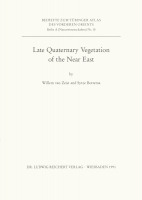Short Description
This volume presents a review and evaluation of the palynological examination of Near and Eastern sediment cores covering the last 30,000 years, eith the aim of reconstructing the Late Quaternary vegetational history. The pollen evidence is supplemented by archaeobotanical data.
As the vegetation of earlier times cannot be understood without knowledge of the modern vegetation in relation to environmental conditions, a synopsis of the topography, climate and (potential) natural vegetation is presented. Surface-sample studies inform us as a prerequisite for the interpretation of fossil pollen spectra in terms of vegetations of the past.
A major part of the book is devoted to the discussion of the regional vegetation histories. For each ofthe regions the evidence, usually in the form of abridged pollen diagrams, is presented. Palaeo-vegetation maps prepared for the Northwest Zagros Mountains, Southwestern Anatolia, Northwestern Anatolia and the Southern Levant illustrate the interpretation of the pollen data. The regional maps are of considerable use in the study of prehistoric settlement patterns. In addition, generalized palaeo-vegetation maps for the whole of the Near East, so far as covered by pollen cores, are presented.
In a final chapter the interference of ancient man with the vegetation, as documented in the pollen record, is discussed. In spite of the evidence for large-scale forest clearences, most of the potential forest and woodland areas remained predominantly wooded probably until only a few centuries ago.
The book is of interest to archaeologists, botanists, palynologists, climatologists, geomorphologists and geographers.
Series Description
The Near and Middle East, long too poor and unimportant to be other than pawns in the power politics of this century, no longer cries out for recognition. In the past few years we have become painfully aware of the economic clout of the Near and Middle East and the political muscle connected to it. And yet our knowledge of these countries and the complex forces which determine their character has lagged woefully behind the attention we now lavish on them. The familiar stereotypes, the bazars, coffee houses, camel caravans and bedouin tents, are no longer valid. In their place we see industrial complexes, reclamation projects, irrigation systems and tourism. The old ways are being sifted through the newly awakened nationalism and the realities of contemporary civilization. Some are discarded while others come through the process unscathed to be nurtured and fostered in their own unique ways.
To help supply needed information about this area which now commands our attention, scholars of various faculties at the University of Tübingen decided to pool their talents and diverse disciplines. Thus the idea was born to draft an atlas of the Near and Middle East wherein the latest research and cartographic techniques would be employed to present in a concise and lucid form the results of their separate efforts.
The Tübinger Atlas des Vorderen Orients (TAVO) as the project came to be called will cover the countries from Turkey to Yemen, from Afghanistan to the Sudan, and the countries in between, i. e. Iran, Iraq, Syria, Lebanon, Israel, Jordan, the Gulf States,Saudi Arabia,Egypt and in certain cases Ethiopia and individual Maghreb states.
In order to facilitate the ordered presentation of the contemporary and historical material,two parts, A and B, are planned. Part A covering the contemporary situation will be divided into 10 sections, e. g. orohydrography, geomorphology,
climate, flora, demography, commerce and communications.
Part B, dedicated to the historical dimension of the Near and Middle East, has been intentionally designed to control diachronistic depth (from the paleolithic age to the present) without losing synchronistic breadth. Here, as in Part A, 10 sections are planned, arranged however chranologically rather than thematically, wherein each section will cover one of the main divisions of Near Eastern history.






 Neuerscheinungen 2023/2024
Neuerscheinungen 2023/2024
 Gesamtverzeichnis 2023/2024
Gesamtverzeichnis 2023/2024
 Katalog Oriental Studies & Linguistics
Katalog Oriental Studies & Linguistics
 Mittelalter
Mittelalter
 Deutsche Inschriften
Deutsche Inschriften
 Musiktherapie
Musiktherapie
 Literaturen im Kontext
Literaturen im Kontext